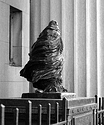I started to do split grade printing about a year ago...shortly after I acquired a complete Zone VI enlarger setup with VC cold light head.
So far so good...and yes, this is indeed a powerful tool in controlling local contrast levels.
But I think my initial approach to testing may be changing. While "conventional" wisdom had suggested I first test to establish highs with the green channel, I sometimes find results a bit difficult to evaluate effectively. So more recently I've begun to test first for shadows with the blue channel - getting to something which feels good intuitively, then layering on with the green channel to "fill in the blanks" as it were.
Yet another suggested testing technique - that of printing an area in a perpendicular grid pattern using each channel for the first (and hypothetically only) test sequence...I find either limiting or wasteful, in that for me this requires a large sheet of paper to get any sense of relativity to the entirety of the image. Thus I'm still starting by establishing a base using one channel, then adding the other to this with a new sequence to get a good baseline exposure.
At any rate...I'd be very curious to have others chime in a bit further regarding their initial testing procedures. As for what seems to be a general consensus that split grade printing saves time...I have yet to find this to be true for me, but I probably just need a bit more practice.
Finally, while the the VC cold light head on my Zone VI seems OK for now, the blue channel does seem to flicker a bit when fully powered up (I thus use this channel at a lower setting) I'm a bit nervous about its working consistently down the road...and am starting to think about alternative light sources.
The Heiland LED heads look amazing - but also very expensive. But I do wonder about the actual contrast range of these led heads. A good friend has been using the Zone VI LED VC head, which was produced very briefly before Zone VI folded. He relates that while generally more even and "flicker-free," his Z-VI LED head does not offer the contrast range (especially in the higher contrasts) when compared to his older cold light version. My hope would be that the Heiland head would offer an improvement here, especially given its cost...but I would like to hear more from others regarding experiences with Heiland heads. Thanks!






